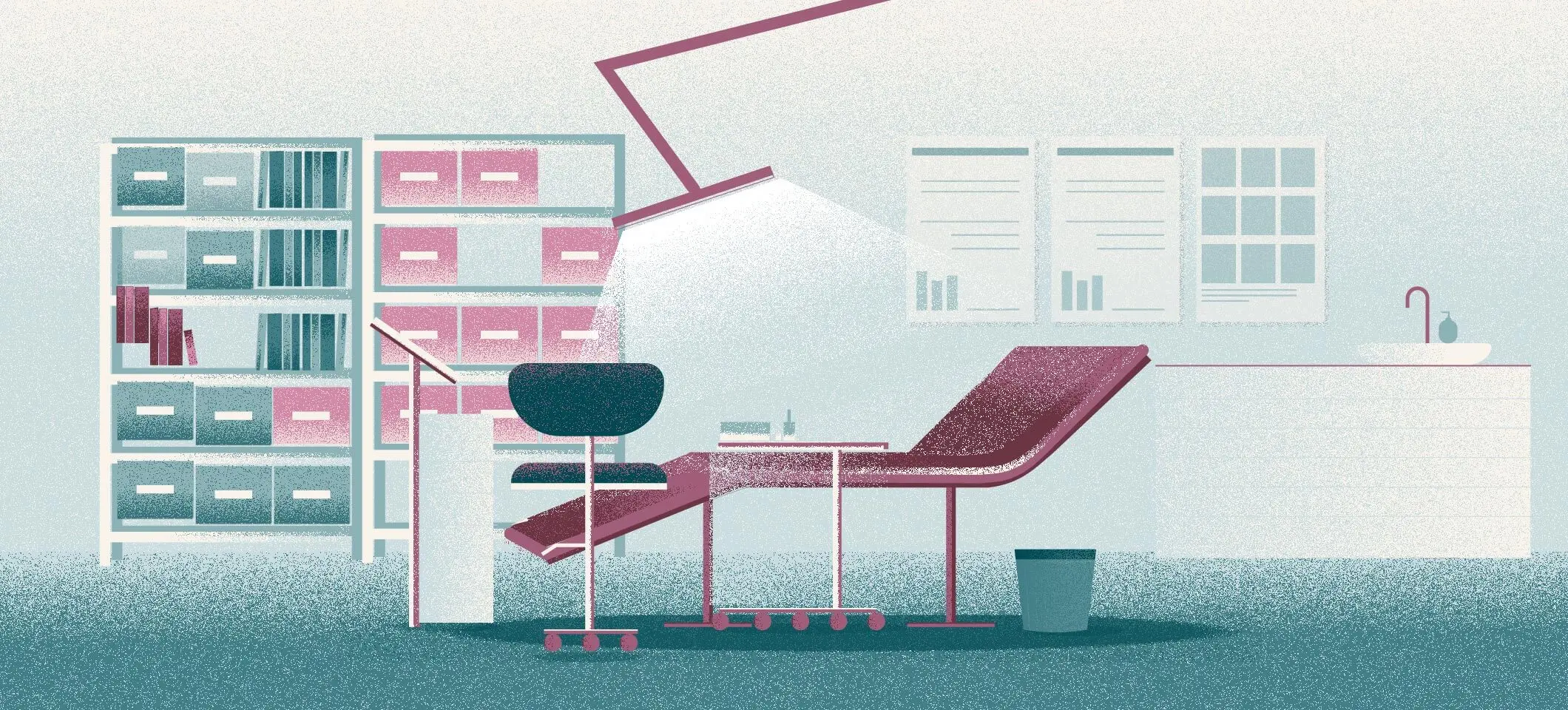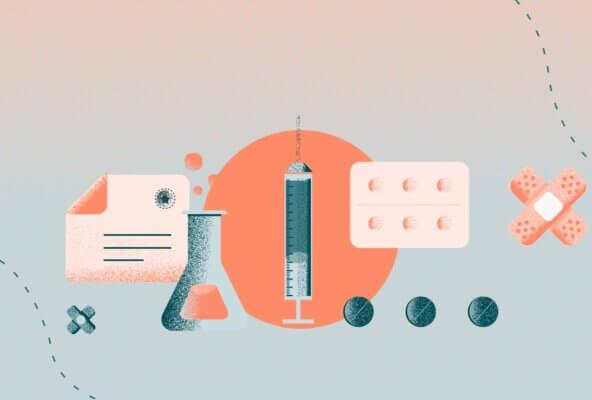Overview
- Essential equipment includes EHR systems, exam tables, and diagnostic tools.
- Invest in telehealth technology to improve patient access and practice efficiency.
- Proper equipment setup ensures compliance, workflow efficiency, and patient safety.
If you’ve ever spent valuable time hunting for a glucometer that works or a box of thermometer probe covers, you know how frustrating it is to not have the right equipment at the right time. Use the best practices and checklists for office and clinical supplies and durable medical equipment below to ensure that your new medical practice has everything your team needs.
How do I find supplies and equipment for my new medical practice?
You’ve located the ideal place for your new medical practice, signed the lease, and obtained the necessary licenses and permits. Now, it’s time to start thinking about filling your medical office with the clinical supplies, durable medical equipment, and administrative and IT tools for success.
“Dependable healthcare equipment and tools enable thorough assessments, accurate testing and diagnoses, and effective procedures.”
Dependable healthcare equipment and tools enable thorough assessments, accurate testing and diagnoses, and effective procedures. As the practice owner, you are ultimately responsible for whether or not your practice is well-stocked and can meet patients’ needs. It’s your job to empower your practice manager or other designated staff to procure and manage medical supplies. Establish that they are responsible for supply needs assessment, vendor selection, order placement, inventory management, cost optimization, quality control, and effective communication. Then work with them throughout the following process.
To get started, work with your practice manager to assess your practice’s supply requirements. Evaluate your expected patient volume and the treatments, ancillary services, and procedures your practice will offer. Be prepared for your needs to change as your practice grows. Your practice manager should conduct regular assessments to ensure that your practice has the clinical equipment and durable medical supplies necessary to meet patient demand.
Vendor selection and relationship management
When equipping and stocking your new medical practice for the first time, research and select reliable suppliers who offer high-quality products at competitive prices. Vendors will vie for your practice's business and there are many variables to consider.
Seek to establish and nurture positive relationships with vendors by submitting orders and paying invoices in a timely manner. Enquire if the vendor offers loyalty or discount programs for wholesale orders or swift invoice payments. Building strong supplier relationships will allow your practice manager to negotiate favorable terms; resolve issues efficiently; and stay informed of new products, procurement issues, or pricing changes.
Orders and inventory management
While your practice manager is responsible for placing accurate and timely orders for medical supplies, they cannot do so if they don’t know what you have and what you need. Build a centralized system to monitor inventory levels, track usage patterns, and set appropriate reorder points to prevent stockouts or excessive stock. Create a system for supply requests and encourage every member of your staff to use it consistently to alert the practice manager about supplies that are running low or expiring.
Cost optimization and budgeting
Establish and manage the supply budget. As your practice grows, encourage your practice manager to seek cost-saving opportunities, negotiate pricing with vendors, and explore bulk or group buying options. By optimizing costs and adhering to the budget, you support both your team’s ability to offer care and your practice’s financial health.
Quality control and compliance
The medical supplies your practice uses should meet quality standards and comply with any regulatory requirements. Your practice manager should collaborate with you and the rest of your clinical team to identify any specific supply needs related to patient safety, infection control, or specialized procedures. Once your practice is up and running, they should plan to conduct periodic quality audits, verify certifications, and review supplier performance to ensure that your practice only receives reliable and safe medical supplies.
What equipment do I need to start a medical practice?
When setting up your medical practice, one of the most critical tools to purchase is an electronic health record (EHR). Your EHR is the foundation for your practice, so choosing the right one should be your top priority when acquiring clinical equipment. After you’ve selected an EHR and the IT equipment you need, you can focus on clinic supplies, durable medical equipment, and administrative tools.
What should I look for in an EHR?
Healthcare providers have several different EHR options and the best one will depend on your practice's specific needs. An EHR is a big investment, so request a demo from different vendors. Invite your practice manager or other trusted team member to explore options with you to find the product that aligns best with your practice’s requirements.
While the most popular EHRs offer similar features such as provider-to-provider communication, templates, and electronic prescriptions, also seek a platform that enables seamless communication and data sharing among different healthcare providers, laboratories, and pharmacies. This functionality is critical for care coordination and collaboration.
Ensure that the EHR you select complies with healthcare industry standards and regulations, such as HIPAA. Choosing a compliant EHR helps protect patient privacy and ensures the secure storage and transmission of sensitive information.
The value of a modern EHR extends far beyond patient care, however. A robust EHR supports efficient practice management with features for appointment scheduling, billing and coding, inventory management, and data and insights. These capabilities streamline practice management, optimize revenue cycle management, and provide valuable insights into the financial health and performance of your practice.
When evaluating different EHRs, also consider the skills and capabilities of your staff. If you have experienced administrators familiar with a particular platform, that platform might be the ideal option, even if it's not the most user-friendly. On the other hand, if you're hiring less experienced or part-time staff, you may prioritize an easy-to-use platform with comprehensive training resources, even if it lacks some advanced features. Budget may also influence your decision.
Whichever EHR you select, allocate time for training. Since your EHR is the cornerstone of your practice's record-keeping, include all staff in the training, even those who have used the platform elsewhere, since there will be customization for your practice. Don't allow physicians or other providers to opt out; the training should be mandatory and include everyone.
Download your free resource now
Access it instantly — just complete the form

What clinical supplies do I need for my medical practice?
Since different types of practices require different equipment, we’ve created checklists for general office and clinic supplies, as well as suggestions for medical supplies and durable medical equipment used by common specialist practices. These lists are not meant to be exhaustive, nor will your practice require every item on each list. Instead, you should use these lists as a starting point when determining what you need to start providing safe, efficient, and effective care to patients.
Medical office equipment
Administrative and office supplies
- Desk with ergonomic chairs for the receptionist, practice manager, medical biller, or any other administrative staff
- EHR
- Computers with Wifi connectivity
- Keyboards, mouses, privacy screens
- Mobile computer systems on wheels
- Wastebaskets for general trash and recycling
- Bookshelves
- File cabinet with lock and hanging file folders
- Digital telephone and answering machine
- Headsets
- Office cell phones for select staff
- Printer, photocopier, and scanner
- Printer paper
- Stationary
- Prescription pads
- Pens, pencils, markers, and highlighters
- Paper clips and binder clips
- Tape
- Stapler and staples
- 3-hole punch
- Calculator
- Manilla file folders
- Business envelopes
- Clipboards
- Extension cords
- Desk lamps
- Clock
- Notepads
- Business cards
- Calendar
- Whiteboard and dry erase markers
- Outgoing mail tray
- Laminator for signs
- Fire extinguisher
- Step stool
- Extra phone chargers or device chargers to loan patients
- Office emergency kit, including bottled water, non-perishable snacks, flashlights and batteries, battery-powered radio, and first-aid supplies
Waiting room and reception area restroom
- Comfortable chairs
- Wall-mounted televisions
- Side tables
- Lamps
- Artwork for walls
- Plants
- Umbrella holder
- Magazine or newspaper rack
- Water cooler and disposable cups
- Trash can
- Hand sanitizer and wall dispenser
- Surgical masks
- Hand soap for restroom
- Toilet paper
- Paper towel or a hand dryer
- Tissues
- Menstrual supplies
- Safety rails, handles, or commode aids
- Emergency assistance alarm
- Sharps container
- Diaper changing station
Break room
- Refrigerator
- Microwave
- Dishwasher
- Table and chairs
- Coffee machine
- Electric kettle
- Coffee mugs, spoons, and miscellaneous dishes
- Dish soap
- Hand soap and hand sanitizer
- Dish towels
- Drying rack
- Cleaning supplies
- Staff lockers or space for personal belongings
- Coat hooks
General clinical equipment
Exam room
- Exam table
- Exam table paper
- Exam light
- Weight scale and measuring tape
- Manual and automatic sphygmomanometer for blood pressure monitoring with cuffs for all sizes, including bariatric
- Pulse oximeter
- Wall-mounted otoscope
- Ophthalmoscope
- Stethoscope
- Glucometer, glucometer strips, and lancets
- Thermometer and disposable probe covers
- Penlight
- Portable headlights
- Tuning forks
- Reflex hammer
- 𝥷Tuning fork
- Nitrile gloves for all sizes
- Sterile gloves kids
- Suture equipment
- Disposal suture removal trays
- Medical scissors
- Forceps
- Speculums
- Telephone for translation services
- Hand sanitizer dispenser
- Surgical masks
- N-95 masks
- HEPA air purifiers
- Hand soap
- Paper towels and dispenser
- Sheets or drapes
- Exam gown
- Dirty linen hampers
- Tongue depressors
- Emesis bag
- Cotton swabs, cotton balls, and gauze pads of various sizes
- Paper tape
- Band aids
- Antimicrobial wipes
- Alcohol pads
- Adhesive remover
- Coat hook
- Extra chair
- Computer station and stool for provider
- Sharps containers
Clinical supplies and durable medical equipment
- Syringes, cannulas, and needles of all sizes and types
- Catheters of all sizes and types
- Single-use medical procedure trays and kits
- Ear syringes and ear wax removers
- Antiseptic wipes, including alcohol, antimicrobial, benzalkonium, betadine, iodine, and witch hazel
- Splints
- Canes, crutches, and walkers
- Wheelchair
- Medicine cups
- Select medications, such as acetaminophen, ibuprofen, antihistamines, epinephrine, nitroglycerin, clonidine, antiemetics
- Medical bandages, gauze, dressings, tape, swabs, sponges, and burn dressings
- Clinical basins and bowls, urinals, bags,
- Orthopedic supports, braces, wraps, shoes, boots, or pads
- Medical casts, padding, and casting removal equipment
- Syringe aspirators
- Dedicated refrigerator for medication or vaccines
- Heating and cooling packs
- Incentive spirometer
- Nebulizer machine, mask, and tubing
- Yankauer and suction device
- IV tubing
- IV fluids
- Medication pole and pump
In-office laboratory equipment
- Autoclave or other sterilization equipment
- Alcohol prep pads
- Human specimen collectors and containers (e.g., urine, blood, tissue)
- Culture swabs and medium
- Tourniquets
- Cannulas, and needles of all sizes and types
- Pipettes
- Point of care testing kits and devices
- Permanent markers
- Specimen bags
- Sharps container
Specialty practice medical equipment checklists
Cardiology
- Electrocardiography machines, including extra paper, lead replacements, and stickers
- Cardiac pacemaker programming equipment
- Echocardiography equipment, including transthoracic probes
- Ultrasound gel and gel warmer
- Holter monitors
- Stress test equipment
- Tilt table
- Crash cart with Advanced Cardiac Life Support protocol supplies
Dermatology
- Dermatoscope
- Cryosurgery equipment such as cryo-probes and liquid nitrogen tanks
- Electrosurgical equipment, including electrodes and electrocautery pens
- Biopsy supplies, such as punches, curettes, scalpel blades, and specimen containers
- Phototherapy equipment for treating for conditions like psoriasis, vitiligo, or eczema
- Dermatological lasers for hair removal, tattoo removal, vascular lesions, or skin resurfacing
- Chemical peels and topical agents for chemical exfoliation and treatment of skin conditions such as acne, hyperpigmentation, or photoaging
- Microdermabrasion equipment
- Scalpels, surgical scissors, forceps, needle holders, and other specialized instruments required for dermatological procedures and minor surgeries
Gastroenterology
- Endoscope and endoscopy accessories, including biopsy forceps, snares, retrieval devices, cytology brushes, injection needles, and other tools necessary for therapeutic procedures
- Endoscopic ultrasound equipment
- Colonoscopy equipment and sterilization system
- Anesthesia monitoring equipment for anesthesia staffing who perform endoscopic procedures
- Hemorrhoid treatment equipment, such as hemorrhoidal banding systems and infrared coagulators
- Fecal/stool management kits and catheters
- Enema and impaction supplies
- Bowel prep medications and teaching supplies
Obstetrics and gynecology
- Fully adjustable examination table with stirrups
- Colposcope and light source
- Colposcopy instruments, including biopsy forceps, endocervical curettes, and cervical punches
- Ultrasound machine with transabdominal and transvaginal probes
- Hysteroscope
- Disposable speculums of different sizes
- Cryotherapy and cryosurgical equipment
- Endometrial biopsy tools
- Fetal doppler
- Suction and irrigation system
- LEEP/LLETZ equipment
- Vaginal and cervical swabs
- Perineal care supplies
- Postpartum pads
- Breast pump
Ophthalmology
- Slit lamp biomicroscope
- Ophthalmoscope
- Phoropter
- Tonometer
- Pachymeter
- Specular microscope
- Visual field analyzer
- Contact lens cleaning solutions
- Eye charts
Otolaryngology (ENT)
- Endoscopy equipment with light sources
- Video displays, including videostroboscopy
- Headlights
- Office microscopes
- Audiology sound booths
- Audiometer and audiology software
- Tympanography
- Auditory brain response (ABR) equipment
Pediatrics
- Child-sized exam equipment
- Developmental assessment tools
- Extra diapers of all sizes
- Stickers and other incentives
- Vaccine Information Sheets (VIS) from the Centers for Disease Control
- Colorful band aids
- Tympanic thermometer
Neurology
- Electroencephalography (EEG) machine
- Electromyography (EMG) machine
- Nerve Conduction Study (NCS) equipment
- Transcranial Doppler (TCD) ultrasound system
Urology
- Bladder scanners
- Urostomy supplies
- Bladder control pads, briefs, liners, underwear, pants, and diapers
- Urinalysis strips
- In-dwelling catheter kits and leg bags
- Straight catheterization supplies
Emergency medical equipment
- Depending on your patient population and distance from emergency medical services, you may need to have emergency medical equipment readily available at your practice to ensure the safety and well-being of your patients.
- Automated External Defibrillator (AED)
- Portable oxygen tank or concentrator with nasal cannulas and non-rebreather masks
- Emergency intubation equipment, such an oropharyngeal airway
- Emergency medications such as epinephrine, naloxone, oxygen, aspirin, and nitroglycerin
- Bag-Valve-Mask (BVM) device
- Suction machine
- Emergency crash cart
- Splinting and immobilization equipment, such as splints, immobilizers, and bandages
- Emergency lighting with a backup power source
- Emergency communication system to quickly alert staff members or call for external assistance
- Emergency contact information, including a list of emergency contact numbers, including local emergency medical services (EMS), nearby hospitals, and poison control centers
How often should I inspect medical equipment?
Regularly inspect and maintain all your medical equipment, particularly emergency equipment, to make sure that it has not expired. Your practice must choose between different methods of inspection and maintenance. Some vendors can arrange for third-party maintenance contracts or maintenance can be conducted by the manufacturer. Determine what makes sense for you practice and create an in-office protocol for who should be alerted when equipment needs maintenance.
“Regularly inspect and maintain all your medical equipment, particularly emergency equipment, to make sure that it has not expired.”
Make sure that your entire staff has taken a basic life support (BLS) course and know their role during an emergency. Depending on your speciality and patient population, consider requiring your clinical staff to take advanced cardiac life support (ACLS) training to enhance your practice's emergency response capabilities.
Designate a member of your clinical staff to liaise with local emergency rescue personnel and stay updated on all current and emerging guidelines and recommendations related to disaster and emergency preparedness. Invite EMS staff to the office to meet everyone and work with them to conduct regular fire and emergency drills with your team to make sure everyone knows how to use emergency equipment correctly and understands their role in an emergency situation.
Ensuring supply chain stability for your medical practice
Supply chain instability is not a new problem in healthcare, but the beginning of the COVID-19 pandemic underscored just how profound the impact of procurement disruptions can be to the health and safety of patients and providers alike. Since supply fragility and supply shortages continue to make headlines, it’s important to build resilience into your medical equipment procurement processes.
Here are 5 suggestions to optimize supply chain management for your medical practice.
1. Foster positive vendor relationships
Cultivate strong relationships with reliable suppliers and manufacturers who provide high-quality products and services, selecting local vendors whenever possible. These relationships are crucial and go both ways, particularly with manufacturers who want to sell more of their products and accessories.
Regularly communicate with your vendors to ensure timely delivery, resolve issues promptly, and negotiate favorable terms. Empowering your administrative staff to collaborate closely with trusted suppliers helps ensure that your practice receives a steady supply of the medical equipment you need and reduces the risk of disruptions to patient care.
2. Implement inventory management systems
Explore user-friendly and cost-effective inventory management systems designed for small-scale operations and work with your practice manager to select a cloud-based platform that can track stock levels, manage expiration dates, and generate inventory reports efficiently. Designate a clinical staff member who can work with your practice manager to ensure that inventory management systems are straightforward and prioritize accuracy in tracking stock to prevent wastage, monitor for theft, and minimize excess inventory.
3. Collaborate with nearby healthcare providers
Forge relationships with healthcare providers in your building or neighborhood to share information and resources. Collaborating with other practices, clinics, and even pharmacies can help optimize supply chain management through joint purchasing, group negotiations with suppliers, and sharing best practices. By pooling resources, small practices can benefit from increased purchasing power and cost savings.
4. Embrace digital tools within your budget
Use digital tools that can improve supply chain management without breaking the bank. Explore free or low-cost inventory tracking apps, barcode scanning solutions, and online ordering platforms. These tools can simplify processes, reduce manual errors, and provide better visibility into your supply chain. Work with your administrative staff to select user-friendly technology with relevant features.
5. Continuously assess performance and seek improvement opportunities
Regularly review your supply chain performance by monitoring key metrics specific to your practice's size and operations. Keep track of order accuracy, delivery times, and inventory turnover. Conduct periodic evaluations of your suppliers' performance, considering reliability, responsiveness, and pricing competitiveness. Seek feedback from staff members and explore improvement opportunities that align with your resources and capacity.
It’s impossible to guarantee that your practice will never face supply disruptions, but implementing these steps can go a long way toward helping your medical practice effectively manage its supply chain, enhancing efficiency, reducing waste, and optimizing resource allocation.
Download your free resource now
Access it instantly — just complete the form







